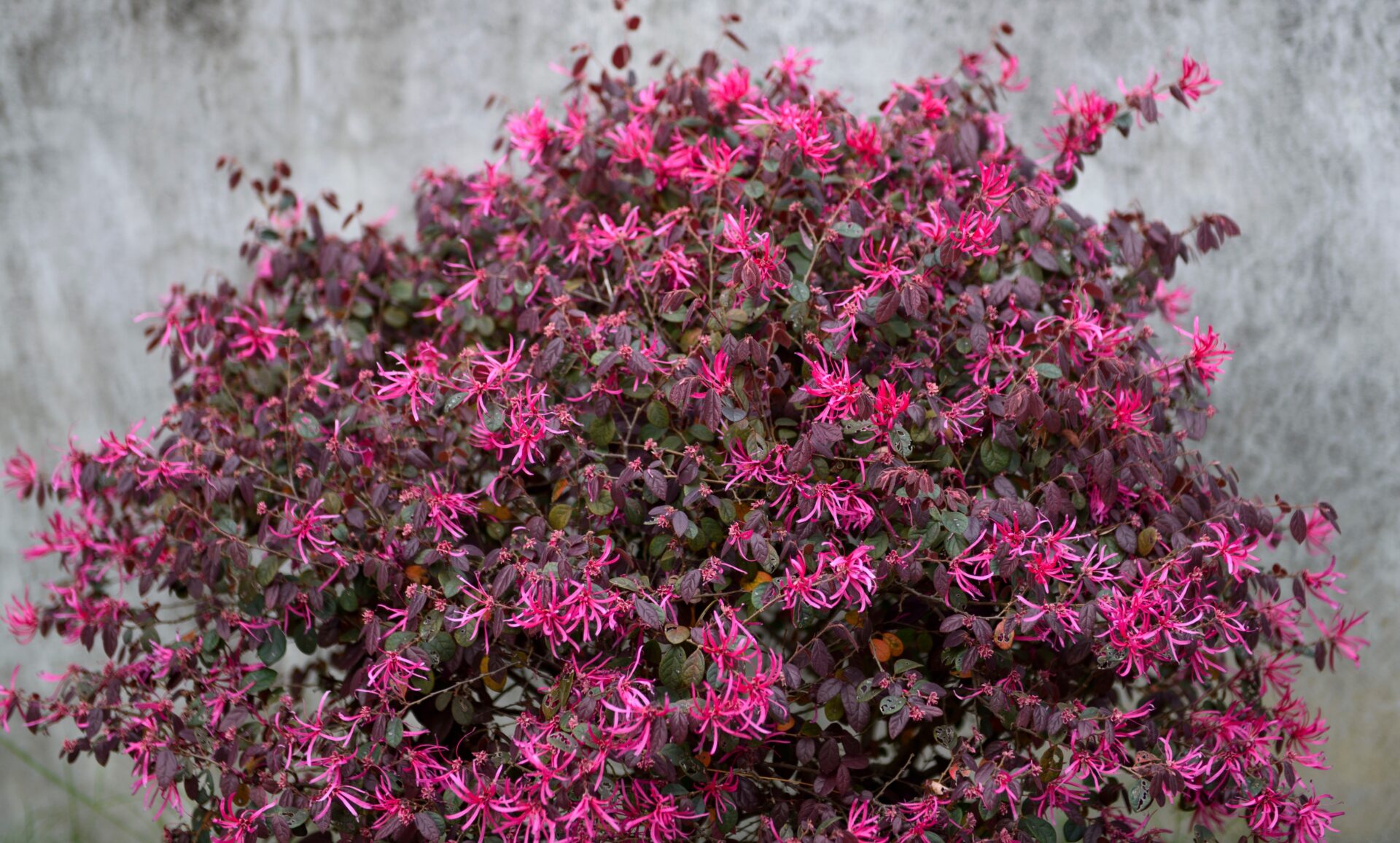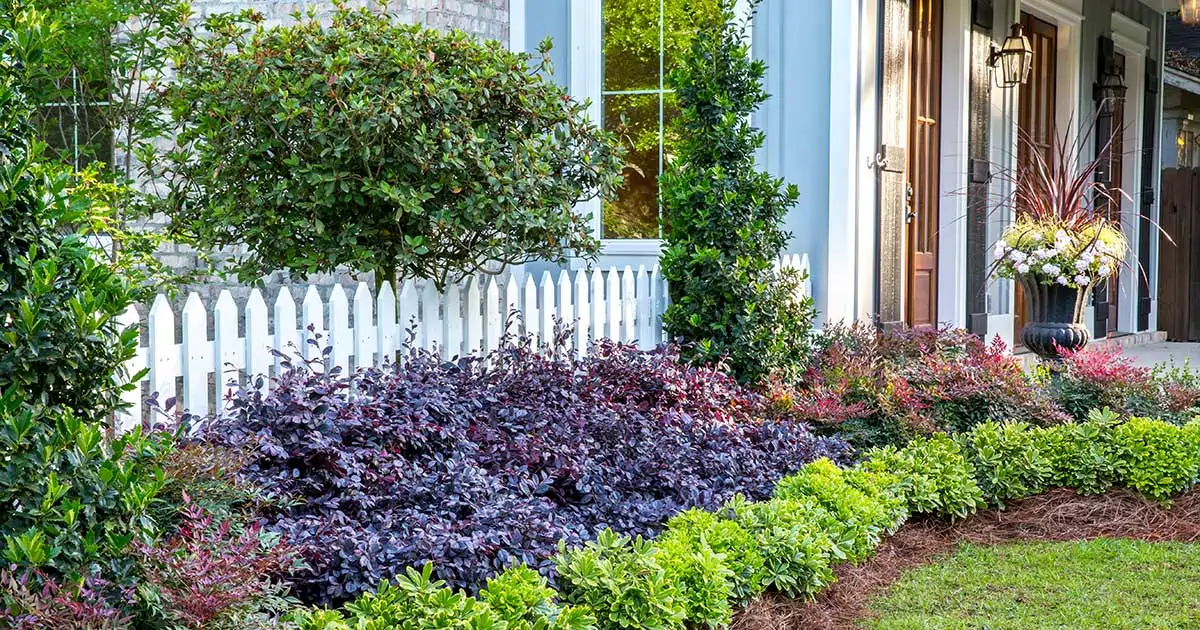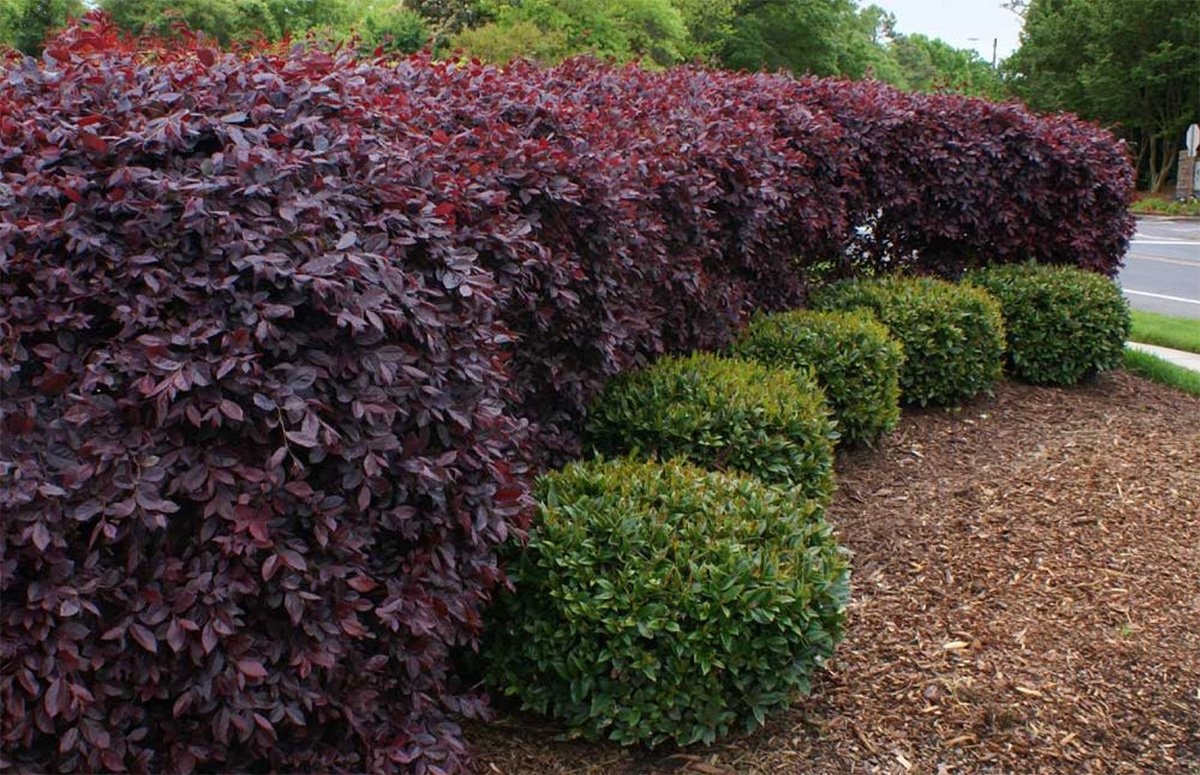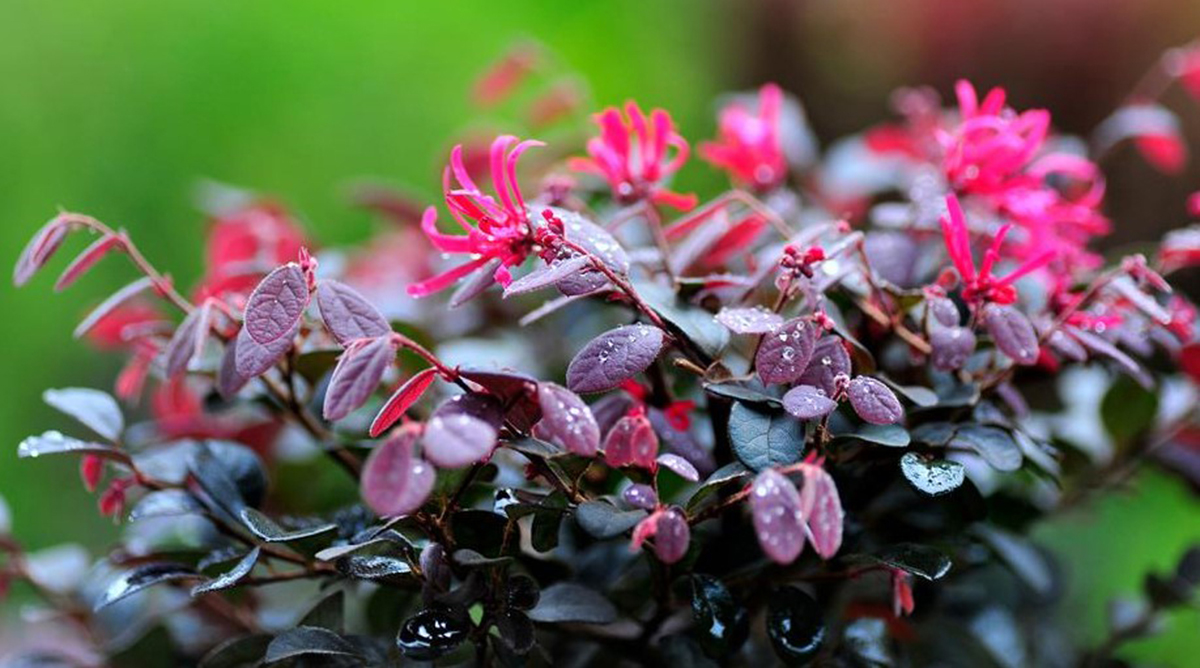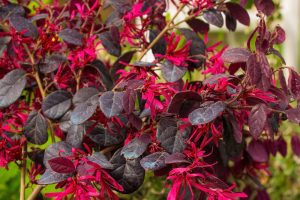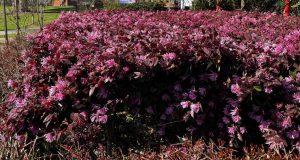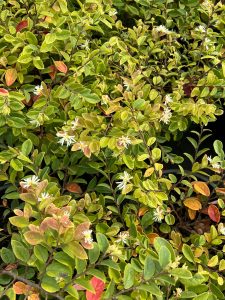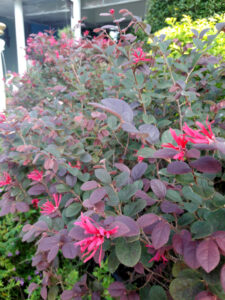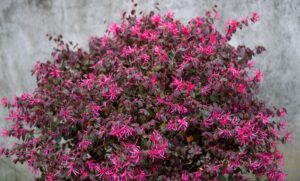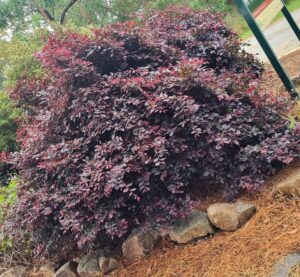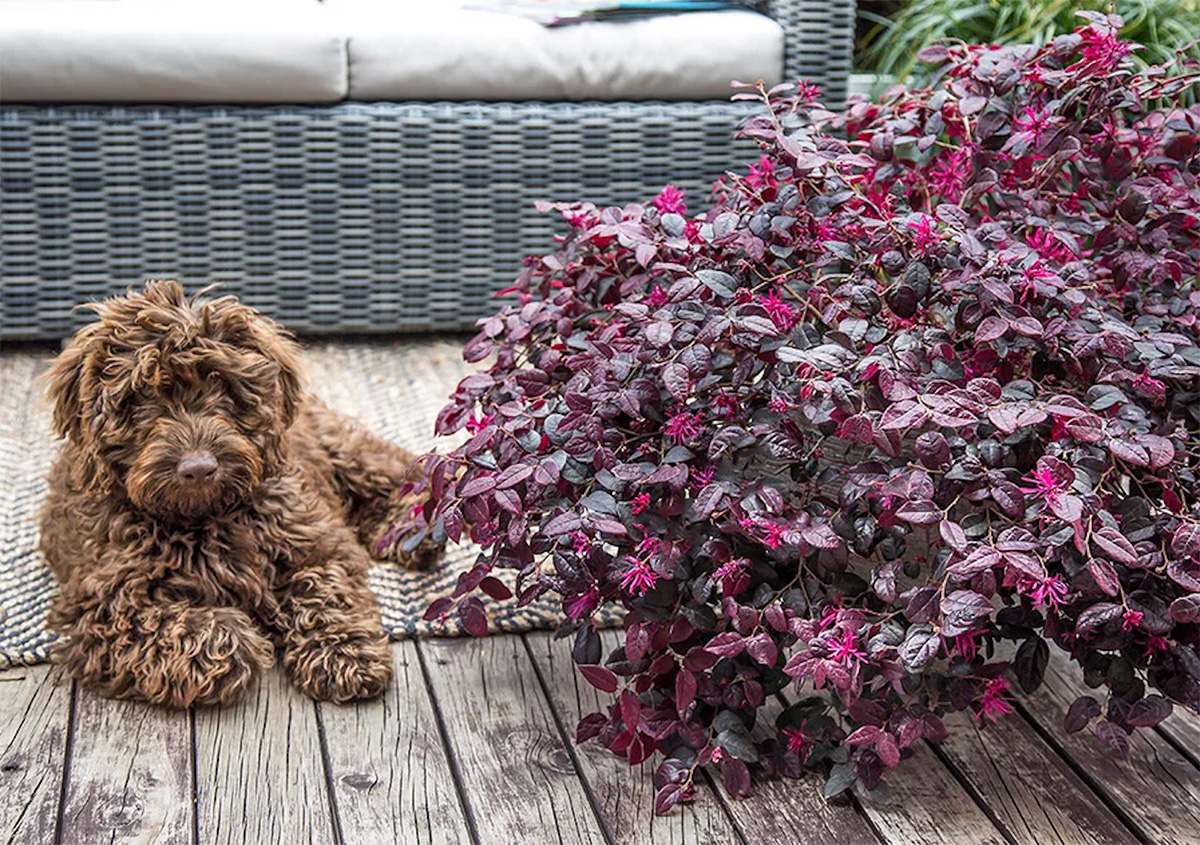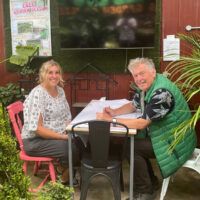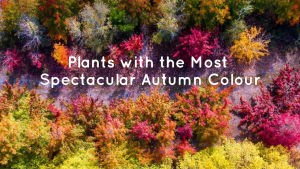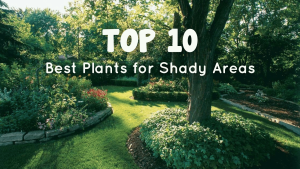Applications of Loropetalums
One of Loropetalum’s strengths is their versatility in the garden.
They do beautifully in pots, and what’s fun about this is that you get an extra feature to play with and add intrigue to your garden. For example, you could pick out a dark pot that intensifies the drama of Loropetalums, such as our Seafoam Bronte Planter Dark Grey.
Or you could provide a stark contrast with a white pot like our GardenLite SquatCongo that’s really going to set off the deep purple tones of a Loropetalum like Plum Gorgeous.
You could even pick a complimentary colour shade with our Glazed Squat Egg Blue pot that is a rich deep blue and would blend beautifully with the pink-purple foliage of Loropetalums.
 Loropetalums make for excellent topiaries – run them up a stake, trim them into a ball on a stick or turn them into a nice cone. Just let you imagination run wild with what shapes to make them because they love a good trim. Place them at the entrance of your home for maximum impact.
Loropetalums make for excellent topiaries – run them up a stake, trim them into a ball on a stick or turn them into a nice cone. Just let you imagination run wild with what shapes to make them because they love a good trim. Place them at the entrance of your home for maximum impact.
They are fantastic for mass planting. When I do a garden design, I’ll often plant three to five of them together for a good splash of colour.
The next thing you could do is plant them as a border. They make for beautiful colourful borders, but there are some types that are better suited to this. We’ll get into this in a sec.
The Best Loropetalums
When we talk about the best Loropetalums, what we really mean is the best Loropetalum for YOU. Everyone has different needs and preferences.
So for each type of Loropetalum, we’re going to describe their applications and characteristics so you can decide what is best for you (and your exciting garden).
Bobz Pink, White and Red
For simplicity I’m going to put all of these together. They each have their own distinct colourway, but when it comes to most suitable applications, they are the same.
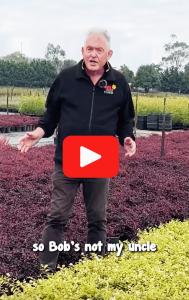 So if you’re after a low groundcover or border, these are the best options out of our Loropetalums. They don’t grow up too high, like some other Loropetalums do.
So if you’re after a low groundcover or border, these are the best options out of our Loropetalums. They don’t grow up too high, like some other Loropetalums do.
Now the foliage on Bobs Pink and Bobz Red might look very similar, but come spring, they’ll be distinct in their colour of flowers. Bobz Red, of course, has bold red/fuchsia pink flowers. Bobz Pink has bright pink/purple flowers. These flowers are small and spidery, but absolutely cover the bush.
If you have a dark brick house or fence, Bobz White is a very refreshing addition, with bright green foliage and beautiful white flowers. Bobz White is great in modern or green and white gardens.
-
Loropetalum ‘Bobz Red’ 7″ Pot
0 out of 5 0$29.99Original price was: $29.99.$17.99Current price is: $17.99. -
-
Loropetalum ‘Bobz White’ 7″ Pot
0 out of 5 0$29.99Original price was: $29.99.$19.99Current price is: $19.99.
Purple Prince
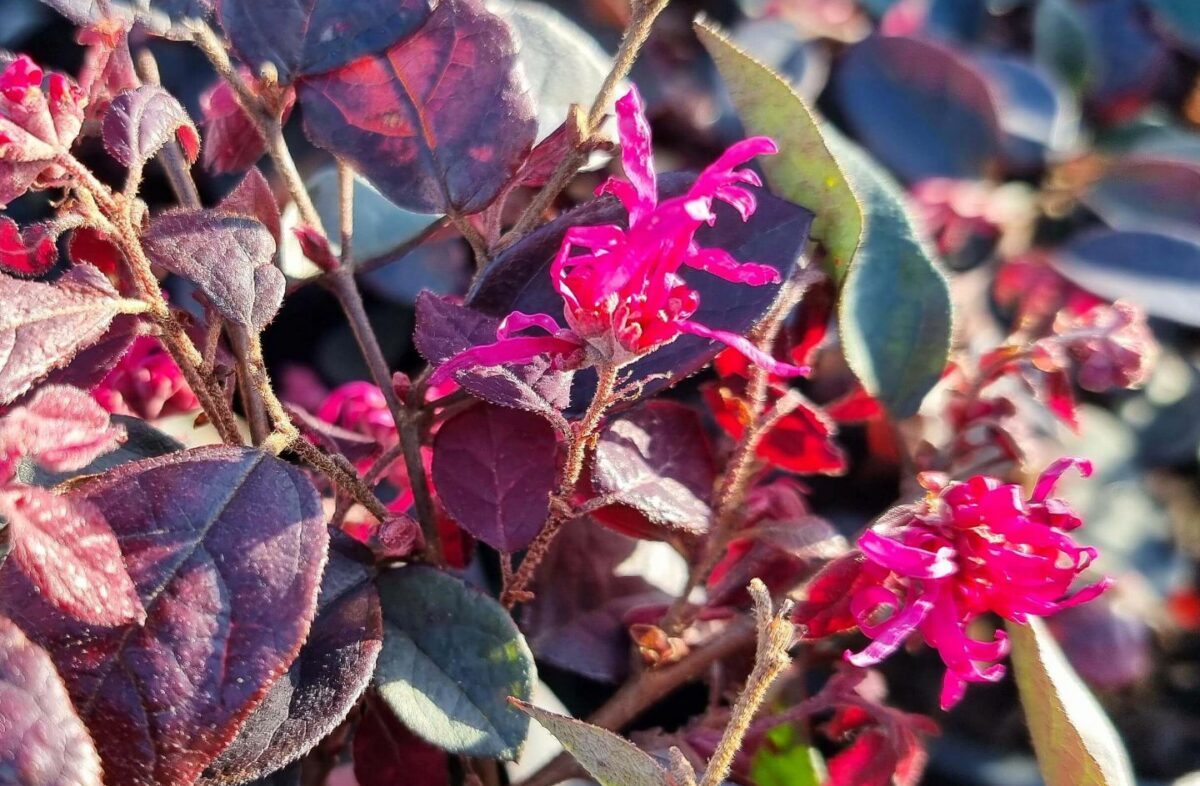 A very interesting and upright Loropetalum, Purple Prince is great for a tall narrow hedge.
A very interesting and upright Loropetalum, Purple Prince is great for a tall narrow hedge.
 Being such a fast grower you don’t have to wait long for it to be a decent size. It will reach a maximum height of about three metres, but you can keep it smaller with trimming.
Being such a fast grower you don’t have to wait long for it to be a decent size. It will reach a maximum height of about three metres, but you can keep it smaller with trimming.
It has deep purple foliage developing into burgundy in the spring and pink, fuchsia flowers.
Purple Prince is great also great for mass planting as they mound quite nicely.
Plum Gorgeous
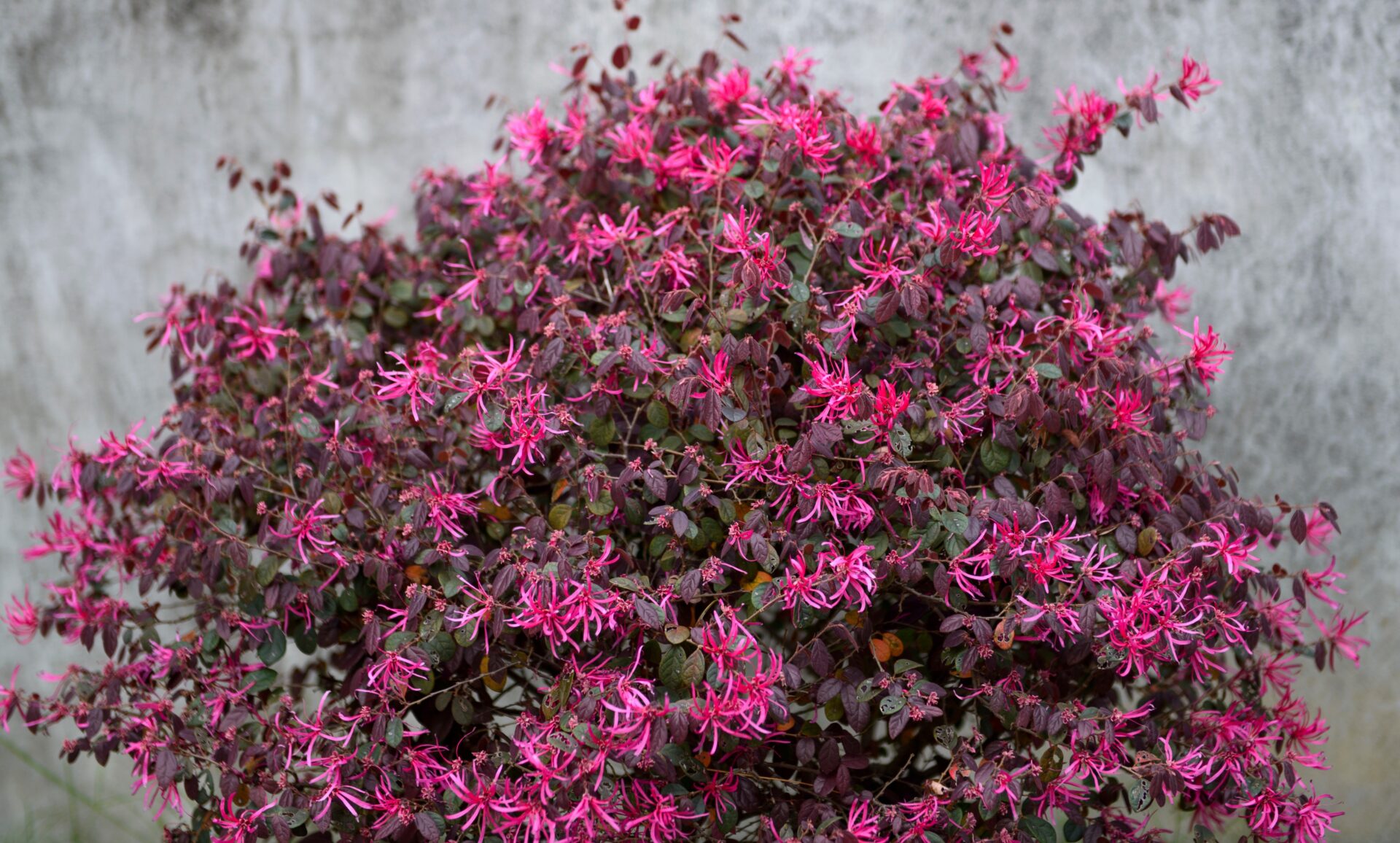
 The most striking colour of all the Loropetalums, Plum Gorgeous has deep purple foliage and bright pink flowers. It is a good strong grower and if you trim it, Plum Gorgeous will grow very wide. It is one of the largest Loropetalums.
The most striking colour of all the Loropetalums, Plum Gorgeous has deep purple foliage and bright pink flowers. It is a good strong grower and if you trim it, Plum Gorgeous will grow very wide. It is one of the largest Loropetalums.
Plum Gorgeous is great for shady areas because their foliage is so intense. With some Loropetalums you can notice the foliage lightening in spots that don’t get much sunlight.
They are great to underplant trees, cover beds or as an informal border around walls.
China Pink
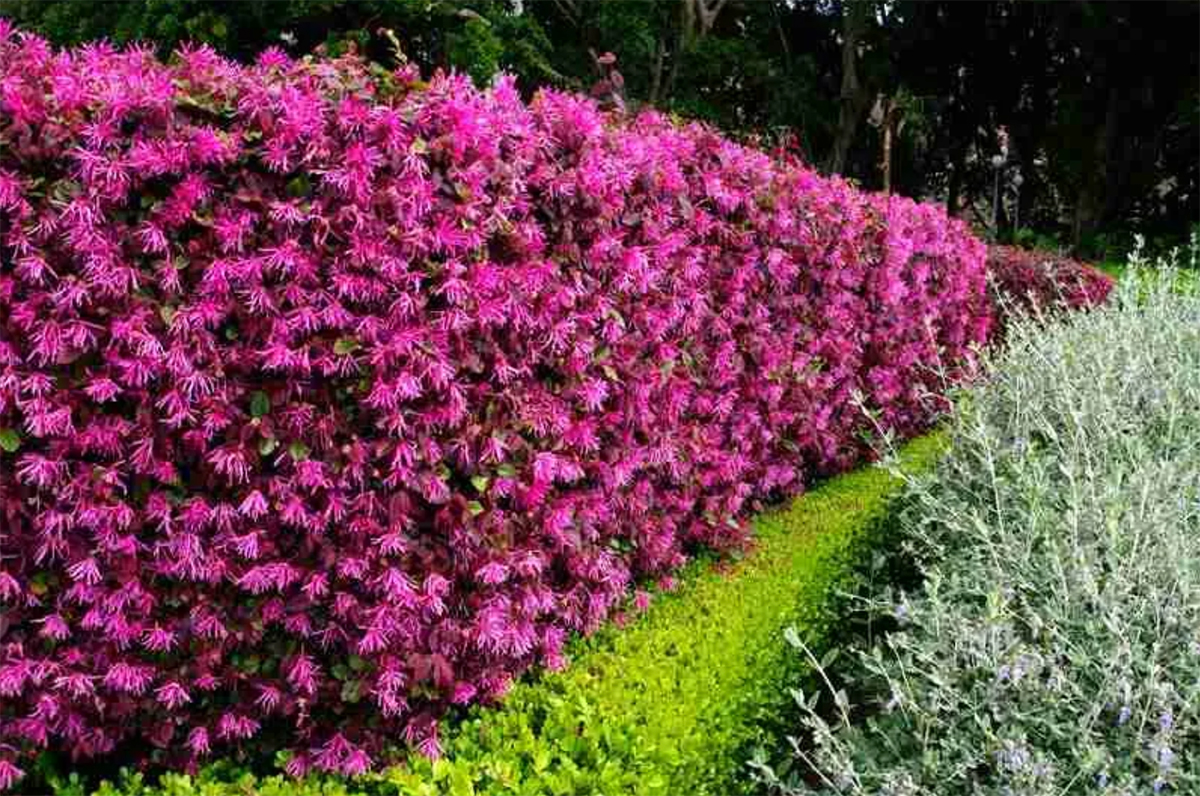 China Pink
China Pink is the cheapest Loropetalum. Not because of a lack of quality, but because other Loropetalums are patented and have royalties that need to be paid.
is the cheapest Loropetalum. Not because of a lack of quality, but because other Loropetalums are patented and have royalties that need to be paid.
The candy pink flowers contrast nicely with the dark reddish-purple foliage.
Clip it into a purple hedge for something a bit different from the usual English Box hedge.
-
Loropetalum ‘China Pink’ 12″ Pot
0 out of 5 0$110.00Original price was: $110.00.$99.99Current price is: $99.99. -
-
Loropetalum ‘China Pink’ 8″ Pot
0 out of 5 0$33.99Original price was: $33.99.$29.99Current price is: $29.99. -
Loropetalum ‘China Pink’ 6″ Pot
0 out of 5 0$16.99Original price was: $16.99.$14.99Current price is: $14.99. -
How to Take Care of Them
Loropetalums like nice loose soil. If you have hard clay soil, then you need to dig it up and combine it with potting mix so that it becomes light and airy. They also need plenty of water.
 But if you get these two conditions right, soil and water, then you’ll find they can take quite hot, difficult conditions.
But if you get these two conditions right, soil and water, then you’ll find they can take quite hot, difficult conditions.
You also can’t go astray with some osmocote and fertiliser.
They can grow in full sun or deep shade but be aware that less sunlight means less intensity in the foliage. They need about three to four hours of sunlight to get that real brightness of colour. So although they’re great for some colour in the shade, they’re going to do better in sunny spots.
Some of Our Garden Designs Using Loropetalums
We’re going to give you a sneak peek into some of Chris’ Garden Designs to give you insight into how you can build a captivating garden using Loropetalums.
This is a great example of a Japanese style garden:
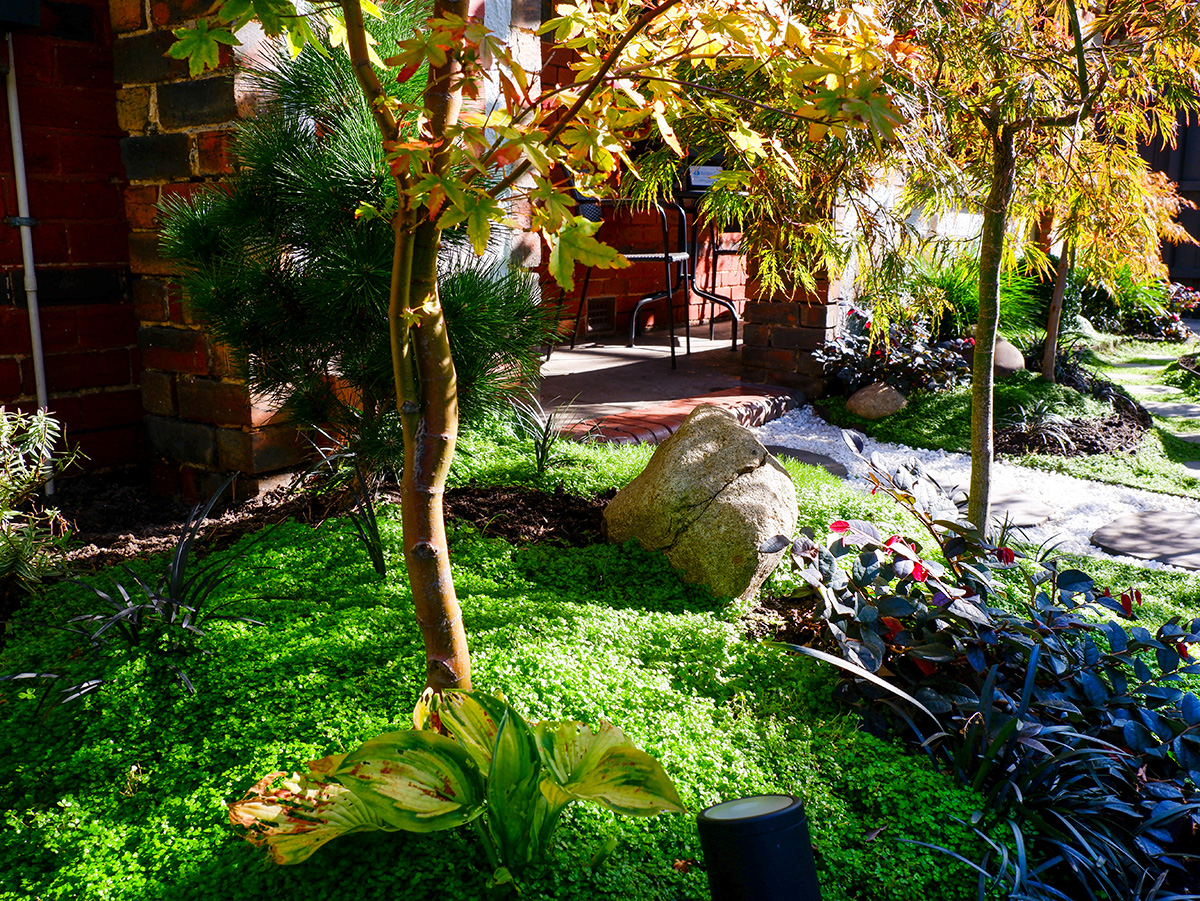 Often when I do a Japanese style garden, I’ll plant a purple weeping Japanese Maple like an Atropurpureum, with a Loropetalum at its base.
Often when I do a Japanese style garden, I’ll plant a purple weeping Japanese Maple like an Atropurpureum, with a Loropetalum at its base.
Then in another part of the garden I’ll place a Loropetalum ‘Plum Gorgeous’, Abelia ‘Kaleidoscope’ and Helichrysum ‘Licorice’. All of these together make for a captivating interplay of colours and textures.
 The Loropetalum provides deep purple hues, the Kaleidoscope has fine golden-green leaves, and the Licorice has bright silver foliage. They grow to be around the same size and have similar textures, but the excitement comes from the contrasting colours.
The Loropetalum provides deep purple hues, the Kaleidoscope has fine golden-green leaves, and the Licorice has bright silver foliage. They grow to be around the same size and have similar textures, but the excitement comes from the contrasting colours.
I make sure to tell my customers to clip these into balls for the maximum effect.
Here is a great solution for small shady spots:
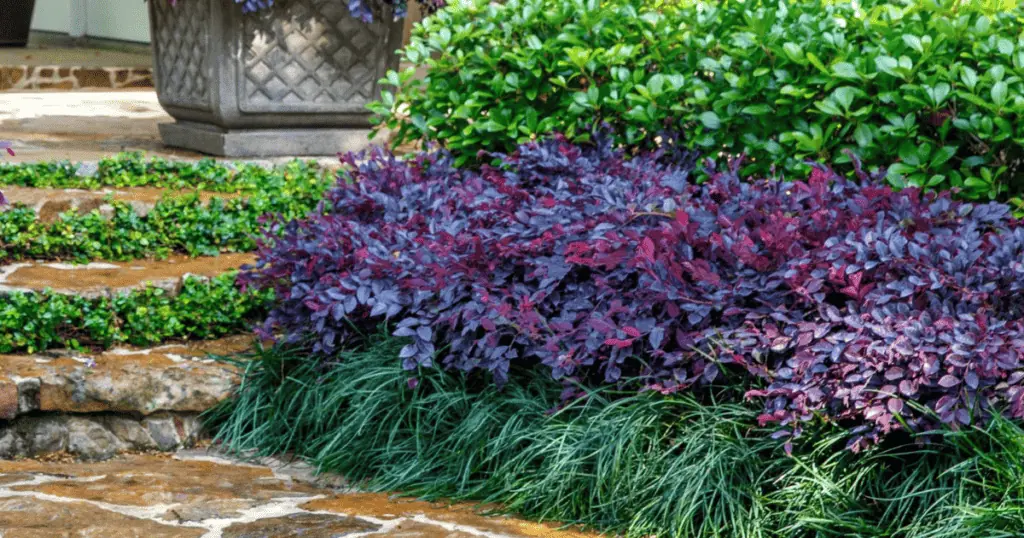 A lot of people have a skinny garden bed up the side of their house with a big window looking out on it. You’ll also find that with these areas they don’t tend to get a lot of sunlight.
A lot of people have a skinny garden bed up the side of their house with a big window looking out on it. You’ll also find that with these areas they don’t tend to get a lot of sunlight.
Yes, Loropetalums aren’t going to be as vividly colourful here, but that doesn’t mean they don’t still provide an excellent source of colour in shady spots.
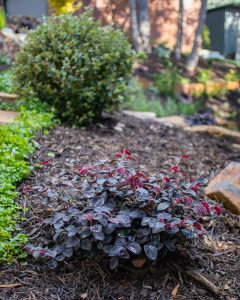 So what I’ll do first is plant a Camellia sasanqua as a screening option to give some privacy. They have dark green foliage and produce stunning flowers in autumn or summer.
So what I’ll do first is plant a Camellia sasanqua as a screening option to give some privacy. They have dark green foliage and produce stunning flowers in autumn or summer.
Then also up against the fence, I’ll plant a Loropetalum between each Camelia sasanqua.
In front of these line of Loropetalums and Camelias, I’ll use the Liriope ‘Stripey White’. The foliage is green with bright silver stripes and grows to about 40cm.
All of these plants go together really nicely, and they’re providing you with colour and excitement even in a narrow sunless spot.
For a layered look you can’t go past these options:
I’ll use Purple Prince to grow a hedge of about 1.2 -1.6 metres in height. Because it’s fast growing and tall you’ll get this in no time. Then in front of it I’ll plant a silver hedge, such as the Helichrysum ‘Licorice’ and trim it to be shorted than the Loropetalum hedge. The purple and silver look so good together, and you’re still getting an elevated design from the neatness of the hedges.
 Or another great pairing is a low hedge of Bobz Red with a golden hedge behind, such as your Ligustrum ‘Golden Privet’. The Golden Privet is bright and fresh looking, and contrasts incredibly with the purple-red hues of Bobz Red. Once again, classy but colourful.
Or another great pairing is a low hedge of Bobz Red with a golden hedge behind, such as your Ligustrum ‘Golden Privet’. The Golden Privet is bright and fresh looking, and contrasts incredibly with the purple-red hues of Bobz Red. Once again, classy but colourful.
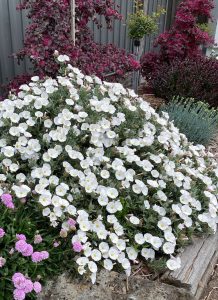 I love doing a border of Bobz Red with a row of Convolvulus ‘Silver Bush’ in front of it. The deep burgundy of Boz Red peeks out over the top of the Silver Bush. That bright silver foliage really makes Bobz Red pop, with the white trumpet shaped flowers providing a nice contrast to the red spidery flowers.
I love doing a border of Bobz Red with a row of Convolvulus ‘Silver Bush’ in front of it. The deep burgundy of Boz Red peeks out over the top of the Silver Bush. That bright silver foliage really makes Bobz Red pop, with the white trumpet shaped flowers providing a nice contrast to the red spidery flowers.
Also don’t feel limited to hedging, remember that Loropetalums are also fantastic as topiaries so you could shape these into balls and plant them next to one another.
We love green and white gardens just as much as the next person, but if you’re looking for something more dynamic in colour, then Loropetalums are the way to go. Their versatility and wide range make it so easy to add excitement to your garden. With all the different applications and plant pairings, get creative with the ways you use Loropetalums.
So try something a bit different from your neighbour.



